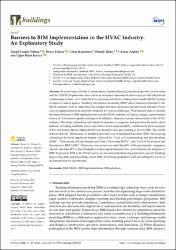Barriers to BIM implementation in the HVAC industry: an exploratory study

View/
Date
2024Author
Yılmaz, İsmail CengizYılmaz, Deniz
Kandemir, Onur
Tekin, Hamdi
Atabay, Şenay
Bulut Karaca, Ülger
Metadata
Show full item recordCitation
Yılmaz, ˙I.C.; Yılmaz, D.; Kandemir, O.; Tekin, H.; Atabay, ¸S.; Bulut Karaca, Ü. Barriers to BIM Implementation in the HVAC Industry: An Exploratory Study. Buildings 2024, 14, 788.Abstract
In recent times, the rise of urbanization, industrialization, population growth, food security, and the COVID-19 pandemic have led to an increased demand for indoor spaces with efficient air conditioning systems. As a result, there is a growing interest in creating more complex HVAC systems to improve indoor spaces. Building information modeling (BIM) offers numerous benefits to the HVAC industry, such as clash detection, budget and time reductions, and increased efficiency. However, its implementation is currently hindered by various challenges. This research aims to identify the major barriers to BIM implementation in the HVAC industry in Turkey, using a questionnaire survey of 224 domain experts working in 42 different companies across various fields of the HVAC industry. The study utilized several statistical analyses to categorize and prioritize the most critical barriers, including reliability tests, exploratory factor analysis (EFA), confirmatory factor analysis (CFA), the Kaiser–Meyer–Olkin (KMO) test, Bartlett’s test, and ranking of factors (IRI). The results indicate that the “Deficiencies of Infrastructure and Lack of Qualified Personnel (DIP)” factor group constituted the most significant barrier, followed by “Lack of Documentation and Specifications (LDS)”, “Deficiencies of Case Studies and Project Drawings (DCP)”, and “Lack of Motivation and Resistance to BIM (LMR)”. Moreover, our research revealed that 60% of the participants’ companies allocate less than 40% of their budgets to technological infrastructure, which hinders the adoption of BIM. To promote BIM in the HVAC sector, we recommend enhancing personnel capacity building, improving skills and knowledge about BIM, promoting guidelines, and providing free access to documentation for practitioners.
Source
BuildingsVolume
14Issue
3URI
https:// doi.org/10.3390/buildings14030788https://www.mdpi.com/2075-5309/14/3/788
https://hdl.handle.net/20.500.12780/800

















